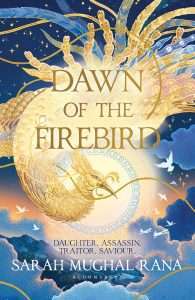My Obsession with my Dagger Collection – and how that led me to Fantasy Storytelling
I was sitting in one of my extra classes at Oxford about the Timurid-Mughal dynasty when I learned a lesson that quietly reshaped the way I think about storytelling: the idea of social history. Instead of studying the past as a neat, linear trajectory – an approach that too often reflects an Orientalist, colonial way of ordering the world – social history urges us to understand an era through the stories of its people, objects, and the intricate social contexts that bind them. It is a discipline of cultural syncretism, local economies, administration, class, and community. It tells us more about how an empire actually functioned than any list of emperors ever could. And in an unexpected way, it mirrors what I love most about fantasy. The genre is not just about applying presentism – our own moral ideas onto another grouping; it is about reading worlds that make us think, whose value systems might clash with our own, whose moral spectrums explore possibilities beyond our comfort, and whose conflicts make sense only when we immerse ourselves in their social structures and material cultures.
 That is how I began shaping the world of Dawn of the Firebird: by looking to the objects people traded and revered, by letting something as small and storied as a dagger reveal its story.
That is how I began shaping the world of Dawn of the Firebird: by looking to the objects people traded and revered, by letting something as small and storied as a dagger reveal its story.
My obsession with daggers began long before I ever owned one. During my martial arts training, I was mastering stances with the goal of eventually wielding a longsword and other blades, but it wasn’t until I began traveling through northern Pakistan that I truly fell in love with the artistry of small weapons. First, daggers shaped the very architecture of trade in Dawn of the Firebird, especially the hustle and bustle of a bazaar. This is where my protagonist, Khamilla, begins to understand that objects do not respect borders, even when empires pretend they do. In her world, a single blade can travel farther than a diplomat, slipping across frontier borderlands and carrying stories, wealth, and power with it. Through these objects, Khamilla learns that trade is the hidden engine behind several empires vying for dominance across prized trade routes: the goods that move through the Camel Road fuel these economies, shift alliances, and even spark the very wars she finds herself caught between.
I still remember seeing a Timurid-Mughal dagger carved from jade and red jade, a material sourced from Kashgar in present-day East Turkestan, carried across mountain passes by traders who linked the Timurid-Mughal Empire to China. That single blade revealed an entire economic and cultural ecosystem: China supplied the nephrite; Mughal artisans transformed it into courtly masterpieces; and by the 18th century, Chinese craftsmen admired the work so much that they began imitating Mughal designs. The spread of finely crafted daggers across Türkiye, Persia, Arabia, and modern-day Pakistan wasn’t just about weapons, it was evidence of the lives of merchant trade networks, shared artistry, and artisans in mutual beneficiary relationships across borderlands.
Understanding how much history a single object could hold inspired the Camel Road in Dawn of the Firebird: a vast trade network shaped not by empires but by shepherds, merchants, materials, and the power of objects crossing borders and evolving, that contradicts the idea of hard borders in our modern day and age.
 Author Sarah Mughal Rana
Author Sarah Mughal RanaSecond, it was by encountering objects from the old Islamicate world, that I realised the dagger was the perfect marriage of my two worlds: the discipline of martial arts and the depth of history. Thus, my dagger collection shaped the magic system in Dawn of the Firebird, particularly through the designs etched into their hilts. In the Islamicate world, jewelled daggers were more than weapons, in the Ottoman and Timurid-Mughal empire, they were ceremonial gifts from the emperor, bestowed upon nobles for military victories or loyalty. For the Timurid-Mughals, the blade was a declaration of rank and favor within the mansabdari system, where numerical titles determined a noble’s status, cavalry command, and place in the imperial hierarchy. But status was never just numerical; it was actually visual. In court, a courtier’s proximity to the emperor, or the material of a blade, the fineness of its carvings, the jewels set into its hilt, high-relief leaves and petals – all of it signaled a ranking in power. That idea, that objects can carry rank, became the cornerstone of my magic system.
In Khamilla’s world, her own ivory hilt marks her as a Zahr-zad, descended from the emperor’s clan. But as the story progresses into the rival empire, her hilt transforms to their designs: gold threading, raven motifs, and even slashes etched into the grip, to indicate her martial status in the magical military academy. In my fantasy novel, those designs don’t just indicate rank; they evolve with Khamilla herself, recording her shifting loyalties.
A dagger in a fantasy world shouldn’t exist just for aesthetics. Good writers use objects like these to build their worlds from the ground up, to reveal social and political realities. And in Dawn of the Firebird, the dagger is more than a weapon, it’s the bond that ties together trade, power, identity, and the shifting world Khamilla must learn to navigate, alongside the reader.
Read Dawn of the Firebird by Sarah Mughal RanaThe post My Obsession with my Dagger Collection – and how that led me to Fantasy Storytelling appeared first on Grimdark Magazine.



